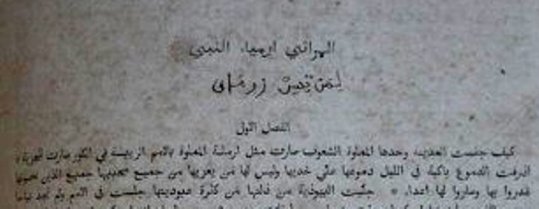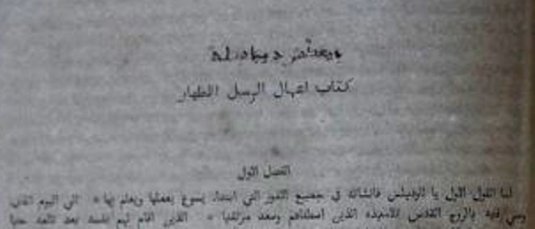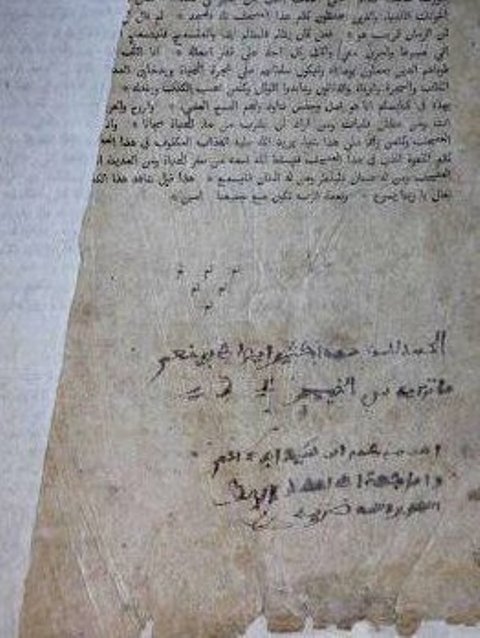Davidson Marginalia
‘Umar ibn Sayyid, Marginalia
E.H. Little Library, Davidson College
Transcription & Translation, Jeffrey Einboden (Northern Illinois University)
Procured for Ibn Sayyid in 1819, The Holy Bible, containing Old and New Testaments, in the Arabic Language (Newcastle Upon Tyne, 1811) offered ‘Umar an opportunity to read the Christian scriptures in his own religious vernacular. However, this Bible would also become an unexpected site for Ibn Sayyid’s personal composition and creation – a space for revising and responding to the sacred text of his American slave “masters” from the vantage of its Arabic margins.
Below is a representative selection from Ibn Sayyid’s Marginalia, coupled with my own transcriptions and translations. For permission to reproduce these images, I am deeply grateful to the E.H. Little Library, Davidson College, which includes the Arabic Bible among its rich collection of ‘Umar materials. I acknowledge, in particular, the generous support of Davidson’s Archives & Special Collections, which graciously hosted my research stay at the library during the summer of 2011. For previous treatment of Ibn Sayyid’s Bible and his Marginalia, see Allan D. Austin’s African Muslims in Antebellum America: Transatlantic Stories and Spiritual Struggles (New York and London: Routledge, 1997), especially pp. 136-137; 140.
Example #1 – Inside Front Cover (Leaf 1)


In advance of its Title Page (above right), Ibn Sayyid prefaces his Arabic Bible with several isolated, but allied, phrases, two of which appear above left:
- ﺍﻠﺤﻤﺩ ﻠﻠﻪ al-hamdu lillāh (“Praise be to God!”)
- ﺍﻠﺨﻳﺭﻋﻨﺩ ﺍﻠﻠﻪ al-khair ‘inda Allāh (“Goodness is from God”)
Example #2 – Opening of Genesis (Leaf 9)

Introducing the Book of Genesis, the 1811 Bible prints a doxology which echoes the Muslim sacred, commencing with the phrase “ﺒﺴﻡ ﺍﻠﻠﻪ ﺍﻟﺮﺤﻤﺎﻦ ﺍﻟﺮﺤﻴﻡ” – i.e. “In the name of God, the Merciful, the Compassionate” (bismillāh ir-rahmān ir-rahīm). However, Ibn Sayyid himself also reduplicates this doxology, choosing to inscribe this Qur’ānic phrase in his own hand above the Bible’s opening, resulting in a repetition of “ﺒﺴﻡ ﺍﻠﻠﻪ ﺍﻟﺮﺤﻤﺎﻦ ﺍﻟﺮﺤﻴﻡ” at the very top of the page.
This superscription is complimented by a final interpolation in the title, Ibn Sayyid labeling the Book of Genesis as “ﺍﻮﻝ ﻜﺘﺎﺏ ﻤﻮﺴﻰ ﺬﻨﺴﺺ” – “The first book of Moses; Dhinisis” (line 6 above). Echoing the traditional attribution of Genesis to Moses (Mūsā), Ibn Sayyid’s inserted phrase also features his first attempt to transliterate an English title (“Genesis”) into Arabic characters (“ﺬﻨﺴﺺ”; Dhinisis) – a cross-linguistic innovation, fusing the divergent sounds and script that form ‘Umar’s complex biography.
Example #3 – Opening of Lamentations (Leaf 536)

Recalling his revised opening to Genesis (Leaf 9), Ibn Sayyid here proposes an alternate heading for the Book of Lamentations, inscribing "ﻠﻤﻦ ﺘﺴﻦ ﺰﺮﻤﺎﻯ” "(Limantisin Zarimāy) immediately below the Bible’s own printed title. Noteworthy as another Arabic transliteration of an English label – vocalizing “Lamentations” as "ﻠﻤﻦ ﺘﺴﻦ" (Limantisin) – this insertion also features ‘Umar’s revision of a biblical name and identity; although his Arabic source ascribes this book to "ﺍﺭﻤﻴﺎﺀ ﺍﻠﻨﺒﻲ” (“Aramayā’, the Prophet”), ‘Umar simply provides the name “ﺰﺮﻤﺎﻯ” (Zarimāy, i.e. “Jeremiah”), emulating English pronunciation, but also omitting the honorific “prophet”.
Example #4 – Opening of the Acts of the Apostles (Leaf 705)

Again vocalizing English through Arabic script, ‘Umar here provides a transliteration of an especially challenging title (“Acts of the Apostles”), inscribing his own version above the Bible’s printed heading. Consistent with his treatment of the Hebrew Bible, this selection exemplifies Ibn Sayyid’s continuing practice to innovate alternate titles throughout the New Testament.
Example #5 – Final Page of Revelation (Leaf 818)

Concluding both the Book of Revelation, and the Arabic Bible as a whole, this final surviving page of ‘Umar’s edition is partially damaged, and its closing inscriptions are nearly illegible. However, the initial line of ‘Umar’s valediction appears to open with: "ﺍﻠﺤﻤﺪ ﻠﻠﻪ ﺤﻤﺪﺍ ﻛﺜﻴﺭﺍ”, al-hamdu lillāh hamdan kathīran (“Praise be to God, much praise”) – a conventional phrase in Muslim religious discourse, which both echoes and extends ‘Umar’s first inscription(i.e. al-hamdu lillāh; cited above). Also featured here is ‘Umar’s own self-identification, his signature visible at the opening to the third line: "ﺍﺴﻤﻰ ﻋﻤﺭﺍﺑﻦ ﺴﻴﺩ" (“my name is ‘Umar ibn Sayyid”).
- Arabic Slave Writings and the American Canon